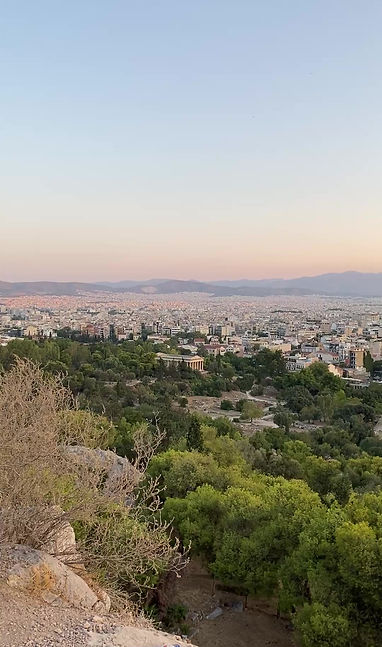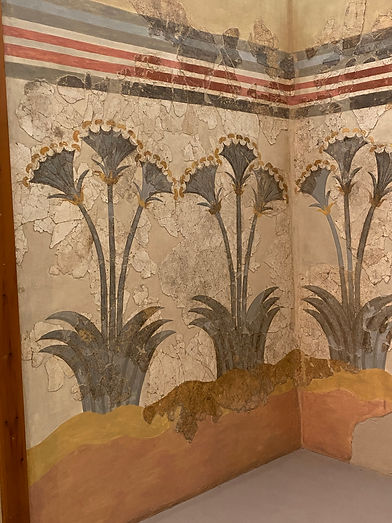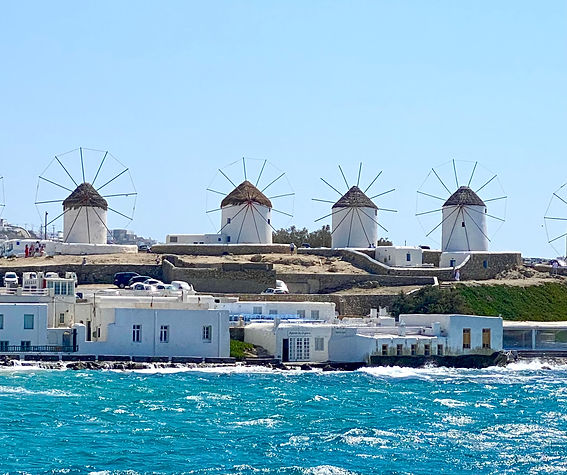
Kauai, Hawaii
Fell Walking in England
Greece is as old as memory. The land of the Iliad and the Odyssey, of Plato and Aristotle, of Zorba and Onassis. It’s where we got democracy and mathematics, baklava and dolmas, and visions of holidays on a sun-soaked mediterranean sailboat floating in an azure-blue sea with dolphins leaping all around, a bowl of peeled grapes in one hand and a glass of ouzo in the other. Okay let’s go sailing!




Background
Even before Greece became the cradle of western civilization, it was home to pre-historic cultures whose artifacts, as old as the 7th millennium BCE, are still being uncovered by archaeologists. Visiting one of these digs really sets the imagination whirring - how people lived and died 9,000 years ago is fascinating and inspired me to appreciate the trappings of our cushy 21st century lifestyle (dentistry, air conditioning, soufflés), and there are lots of opportunities to see relics of ancient Greek civilizations in countless museums or in situ.
Greece is a country closely tied to the sea, with perhaps as many at 6,000 islands representing 1/5 of the country’s total land area. The Greek islands are grouped into 6 major clusters, with the Cyclades perhaps being the most well known and including the islands of Santorini and Mykonos.
The islands were formed by a combination of tectonic plate movements and volcanic activity. Located at the boundary of the African and European tectonic plates, which have repeatedly crashed into and separated from each other during the past 250 million years, the islands formed as the mainland fragmented due to the tectonic movements.
The island of Santorini, which has a classic shape of a volcanic caldera and dramatic cliff-mounted white-washed buildings (looking like barnacles), is the result of the eruption of ancient Mt. Thera around 1600 BCE causing the decline of the Minoan civilization that had flourished there and on Crete.
You will wonder why Santorini has an Italian name and why there are remnants of seemingly venetian architecture here and there - the Venetians occupied this area from the 1200's through the 1500's until it was taken by the Ottomans.
If you google Greek Sailing Vacation you will be accosted with photos of people floating in crystal clear azure water and you will assume that there is no such thing as a wave. And that illustrates my expectations when I signed up for a weeklong sailing trip in the Cyclades islands with G Adventures. I decided to couple that experience with a weeklong food tour with Epitourean in Athens and Aegina.

Climate:
-
There will be virtually no rain during June through August and the temps are in the 80s, which sounds like a perfect environment for vacationing, which is what half the world’s population believes and therefore you will be competing with them if you go during those months.
-
April/May and September/October are great times to find less crowded destinations, although it will be cooler and windier with the potential for some rain.
Currency:
-
Greece is in the Eurozone. Most places will accept credit but it is nice to have some Euros on hand if you are touring some out of the way places. You can get cash at ATMs or a few bills at the airport.
Language:
-
It is not difficult to learn the basics of the Greek language although you must learn the Greek alphabet as well. This is handy though if you want to read signs and directions. You may end up saying “it’s Greek to me” - in a good way.
-
Speaking a little Greek when ordering at a restaurant or in a store will be appreciated. I learned some basics, including pronunciation, from Duolingo. My Greek friends insisted that I had excellent pronunciation, so Thank You Duo!
Transportation:
-
This blog page is mostly about sailing in the Cyclades, so I will not provide you advice about car rental or cross country rail, although those modes are available. I just did not experience them
-
There are speedy ferries that go between the islands frequently and are reasonably priced. These behemoths kick up an impressive wake - watch out when you are near the shore when they leave port!
-
I experienced sailing on a medium sized sailboat from Santorini north to Mykonos and stopping along the way at Ios, Naxos, Paros, and Delos. You should be aware, if you are following this mode, that there are prevailing winds so if you have the choice of direction, check the wind charts and go in the direction that the wind is blowing (in the summer, out of the north).
Ancient relics:
-
Greece is literally awash in relics from the golden age and you will not be at a loss for a glimpse of a piece of architrave lying in the grass or a shard of an earthen amphora in a gravel pathway. The major tourist sites will, disappointingly, be offering up reproductions for the most part - the originals are in Greek or British museums (for safekeeping, presumably). This may not matter to you as the reproductions are fairly accurate, and anyway pretty exotic if you are used to seeing glass and steel modern architecture. Look up local archaeological dig locations and make point of visiting one or ten of them.

To help you make decisions about your trip
Recommendations
Athens and Aegina

When in Athens you must, of course, visit the Acropolis. And everybody else does too so try to go early when it is not as hot.
Don't miss the Acropolis museum at the foot of the hill, and enjoy some local food along the strip.
Hiking around the city can reveal hidden treasures, fabulous views, and interesting neighborhoods. Go for a hike, but avoid the midday sun.

Aaron and I attended a weeklong food tour, partly in Athens and partly on the pretty island of Aegina (known for pink pistachios), a short ferry-ride out of Athens. Who doesn't love Greek food? We learned to cook some dishes and pastries (like Galaktoboureko), and drank quite a bit of Mastic.


Santorini


Once an active volcano that wiped out an ancient civilization, this island has a unique crescent shape. The interior of the crescent is the volcano's caldera and the cliffs down to the sea are precipitous. You will see the bone-white buildings perched atop the cliffs, some cascading down the cliffside, forming a picturesque contrast with the dark brown volcanic native rocks. From afar it looks like snow (or barnacles on the underside of a wooden boat) but up close it looks like Legos on drugs, a seemingly haphazard assemblage of boxes in white, blue, and terracotta.
There are several towns perched along the cliff side of the island and that is where the action is - where all the vacation photos are shot and the tourists flock. Great views (the sunset is legendary), museums and restaurants, and very expensive lodging.
If you prefer serenity mixed in with the beauty you might want to try the eastern side of the island. I stayed at Aghios Artemios Traditional Houses which provides all the destination features you need (such as fabulous meals, swimming pool, laundry service, and friendly hosts who can help you with your Greek lessons) without having to leave the premises. There is a bus that will take you to the caldera side for those times when you need a break from serenity.

Map of Sailing Route
Map Credit: G Adventures
Naxos
Naxos has at last two features to recommend it: the famous Mount Zeus, which is a pleasant half day climb with rewarding views at the top (there are a couple of different routes up or down), and the Temple of Apollo on a little peninsula right off the harbor. It is a large stone rectangular window through which you can photograph the setting sun. There are plenty of good eateries and shopping in the main village at the harbor.
Delos
Delos is a UNESCO world heritage site - an island just off the west coast of Mykonos - whose sole purpose is to house archaeological treasures from the glory days of Olympian Greek gods (the birthplace of Apollo and Artemis), and a thousand years earlier when the island was a holy sanctuary for ancient cultures.
There is a ferry that will carry you there, leaving four times each day during the high season.
The Delos Archaeological Museum is located there, although it was "closed" when we visited. As is the case with most of the ancient sites we visited, the original treasures are in safe keeping in museums, while the "relics" in situ are replicas. If you are not an antiquities expert you may not notice.
Mykonos
Mykonos is a world famous party place - the nightlife is legend. All the beautiful people spend time there and probably have part time residences there. Although not the largest of the Cyclades, it is probably the most visited, with all the amenities you can wish for. Lots of quaint, narrow streets and architectural gems, nightclubs and shops, fabulous beaches, and an airport! And everything is much more expensive than anywhere else. But you can say "I bought this in Mykonos" when you get home and everyone will be duly impressed.
Of course you will have heard about the windmills. These remnants of a simpler past, built in the 1500's to grind wheat into flour, have been standing idle for almost a century since nobody grinds flour anymore. Today they are part of a museum but they are so sculptural and iconic, standing as they do on a promontory visible from the entrance to the harbor and just about anywhere else in town, that you can't stop yourself from taking pictures!
































